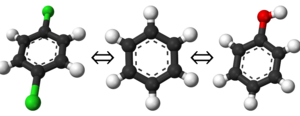Thermodynamic Integration
| Free Energy Fundamentals |
|---|
 |
|
Methods of Free Energy Simulations
|
| Free Energy How-to's |
|---|
 |
Thermodynamic Integration (TI) is one of the most widespread methods for calculating free energy differences. By taking the derivative of the free energy difference with respect to [math]\displaystyle{ \lambda }[/math], this equation can be easily derived. It is one of the few methods that require calculation of [math]\displaystyle{ \frac{\partial U(\lambda,\vec{q})}{\partial\lambda} }[/math], however, is still one of the easiest free energy calculation to work with. The need to calculate the derivative is also one of its limitations as many simulation packages will not calculate this natively, and can cause problems when numerically evaluating it at [math]\displaystyle{ r = 0 }[/math]. Despite this, it is still one of the most accurate methods if used correctly and it is recommended that those new to the field because of its simplicity and ease of use.
Derivation
Starting with the identity of free energy
[math]\displaystyle{ \displaystyle A = -\beta^{-1} ln Q }[/math]
then taking the derivative with respect to [math]\displaystyle{ \lambda }[/math] yields
[math]\displaystyle{ \displaystyle dA/d\lambda = -\beta^{-1}\frac{d}{d\lambda} ln \int e^{-\beta U(\lambda,\vec{q})}d\vec{q} = -\beta^{-1} \frac{\frac{d}{d\lambda}\int e^{-\beta U(\lambda,\vec{q})}d\vec{q}}{Q} }[/math]
which can then be written as
[math]\displaystyle{ \displaystyle dA/d\lambda = -\beta^{-1}\frac{-\beta\int \frac{dU(\lambda,\vec{q})}{d\lambda} e^{-\beta U(\lambda,\vec{q})}d\vec{q}}{Q} = \left\langle \frac{dU(\lambda,\vec{q})}{d\lambda}\right\rangle_\lambda }[/math].
Finally, one can do integration over the whole range of [math]\displaystyle{ \lambda }[/math] to get the final TI equation
[math]\displaystyle{ \displaystyle \Delta A = \int_0^1 \left\langle \frac{dU(\lambda,\vec{q})}{d\lambda}\right\rangle_\lambda d\lambda }[/math].